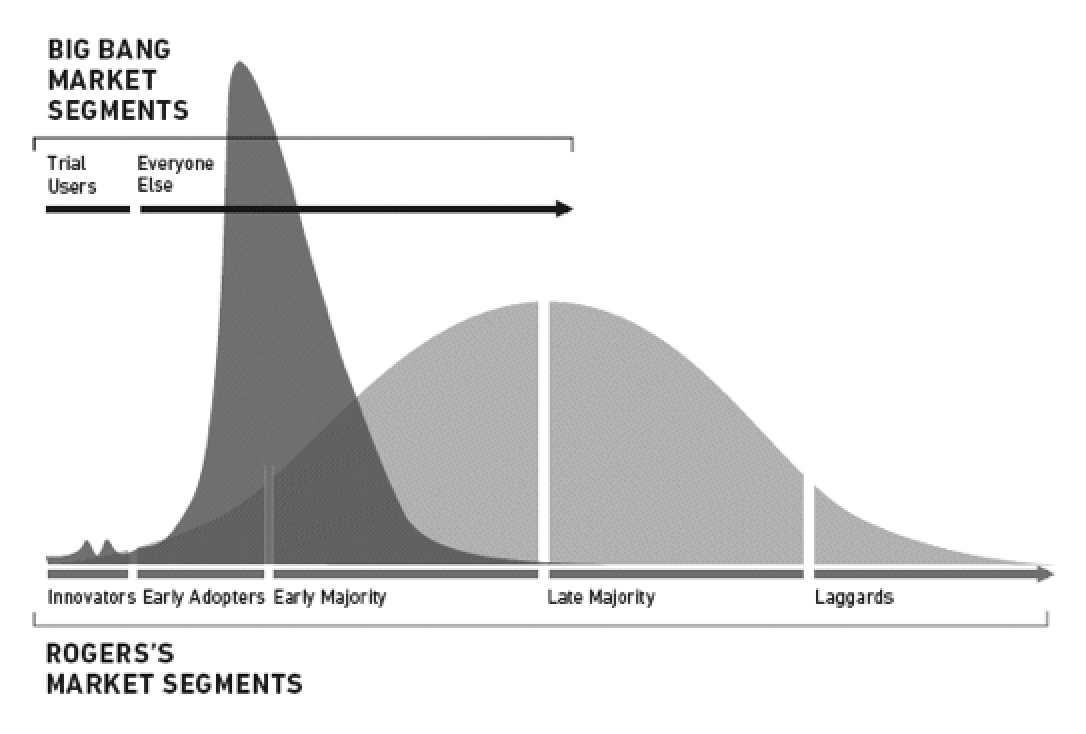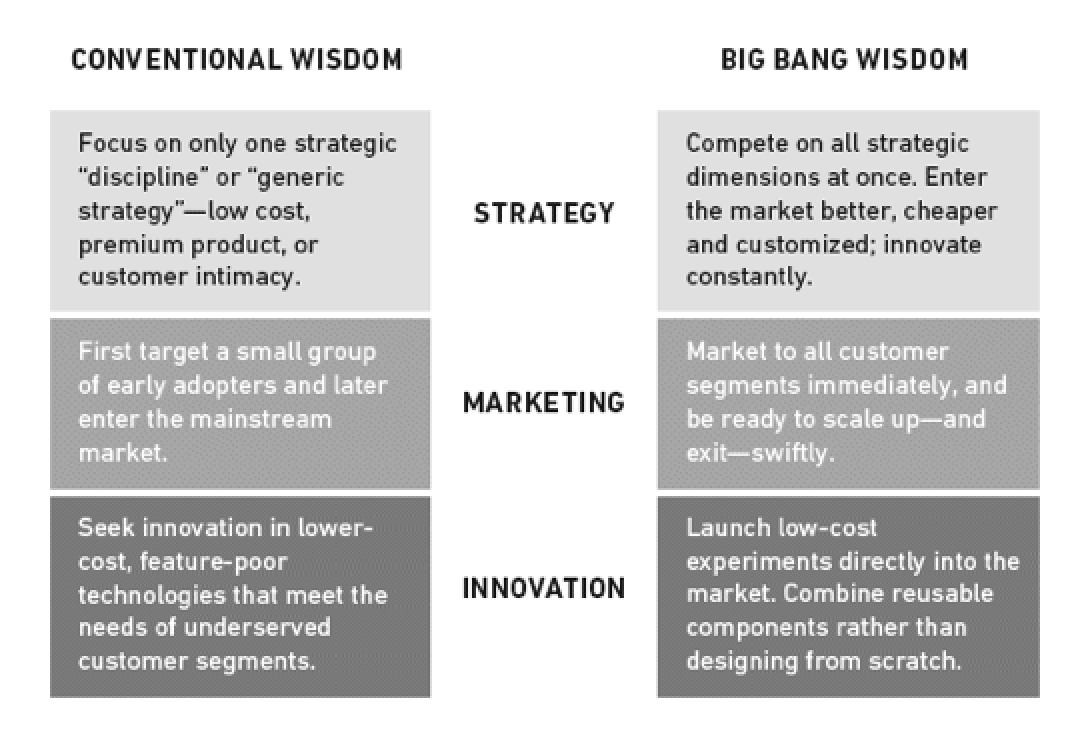Big Bang Disruption [Speed Summary]

- Big Bang Disruption: Strategy in the Age of Devastating Innovation
- Author: Larry Downes and Paul Nunes
- Publisher: Portfolio
- Publication: 2014
The tell-tale signature profile of disruptive innovation is a shark fin – an adoption curve that features a steep curve, brief glory, and then a precipitous fall. And it can be calamitous and devastating for both innovators and the competition.

For competitors, the disruptive innovator – think Google Maps (maps/GPS), Kindle (books), Uber (taxis), AirBnB (accommodation), Netflix (movie rentals) – is a shark-like apex predator that can, and will eat your lunch with innovation that is both better and cheaper, the hallmark of disruptive innovation. For the innovator, the pace of adoption has accelerated so much that old “diffusion” patterns of user adoption– Rogers Diffusion of Innovations and Moore’s Crossing the Chasm – are now redundant – time is squeezed down into a few trial users, then the ‘rush of the rest’. You need to be able to scale to deal with ‘catastrophic success’, and like a shark, you need to keep moving – or die. Stop innovating and you will drown.
Big Bang Disruption: Strategy in the Age of Devastating Innovation is a book about technology and innovation, specifically how technology is the ‘Big Bang’ that can deliver disruptive innovation by both driving down business costs and making the delivery of new benefits possible. Based in part on an Accenture study on disruptive innovation, the authors outline a 12 point strategy for delivering and surviving disruptive innovation. Bottom line, brands need to find their inner-shark – have the energy to work at the pace of a start-up, a venture investor, or a young entrepreneur pulling an all-nighter at a hackathon, fueled by unrealistic hopes and too much caffeine.

- Rule 1. Consult Your Truth-Tellers—Find industry visionaries who see the future more clearly than you do, and who won’t sugarcoat it even when you want them to.
- Rule 2. Pinpoint Your Market Entry—Learn to separate the little bumps from the Big Bangs,choosing just the perfect moment to enter a new ecosystem.
- Rule 3. Launch Seemingly Random Market Experiments—Practice combinatorial innovation directly in the market, collaborating with suppliers, customers, and investors—who may be one and the same.
- Rule 4. Survive Catastrophic Success—Prepare to scale up from experiment to global brand in the space of months, if not weeks, and to redesign your technical and business architecture even while running at full speed. Watch for emerging standards that signal the maturing of winning technologies
- Rule 5. Capture Winner-Take-All Markets—Sacrifice everything, including short-term profits, to ensure victory in winner-take-all markets, especially when success with one disruptor can be leveraged into follow-on products that can be created and launched even faster than the original.
- Rule 6. Create Bullet Time—Judiciously employ litigation and legislation to slow the progress of disruptors, even as you proceed with your own experiments, partnerships, and well-timed acquisitions.
- Rule 7. Anticipate Saturation—When consumers adopt and then abandon new products and services all at once, it’s essential not to be caught with excess capacity or inventory. You need to anticipate saturation before it happens and to scale down as quickly as you scaled up. Poorly timed purchases—whether of raw materials, inventories, or of companies whose value is about to peak—can wreak havoc with your balance sheet.
- Rule 8. Shed Assets Before They Become Liabilities—As one generation of disruptors fades, related assets—factories, distribution networks, and intellectual property—can lose value, gradually and then suddenly. Knowing the right time to sell, and to whom, can mean the difference between your ability to develop the next disruptor and bankruptcy. Knowing which assets to keep for the next cycle of innovation is equally important.
- Rule 9. Quit While You’re Ahead—Even if—especially if—you’ve dominated your industry for decades. The replacement of core technologies with new disruptors can wipe out all your retained earnings quickly if you allow it to. Courageous executives accept the inevitable, and announce their exit from current markets while they are still strong. Doing so gives you more time to move to a new ecosystem. Even better, it forces competitors to change on your schedule.
- Rule 10. Escape Your Own Black Hole—As the lone remaining incumbent, it may seem as if there’s no more competition to worry about. But beware the deadly behavior of your older products and services once better and cheaper alternatives are readily available. Legacy costs, legacy customers, and legacy regulation make it harder, not easier, to compete.
- Rule 11. Become Someone Else’s Components—As humbling as the idea may sound, companies trapped in Entropy often find their best hope is to shut down retail business and transform into a supplier of parts and other resources for innovators in markets emerging elsewhere. When you’re losing the war, in other words, become an arms merchant.
- Rule 12. Move to a New Singularity—Co-opt the tools of the disruptors and their investors, and use them to relocate your remaining assets to a healthier ecosystem. Sponsoring hackathons, opening innovation centers for entrepreneurs, and excelling at corporate venture capital can often buy you the access and equity you need to catch up for lost time and missed opportunities in the early stages.
The BG Take
If a Kodak fate it something you’d like to avoid, you need to keep your finger on the pulse of how technology is threatening to transform your category. The list of retail brands that have already been retired to the deadpool by technology is sobering. But branded consumer staples are under threat too. Think Dollar Shave Club, with 25K razor subscriptions in the first week, and the beauty box brands (Glossybox, Birchbox) that are shaking up the beauty category. If you think technology will not disrupt your category – then you have just become shark food.




